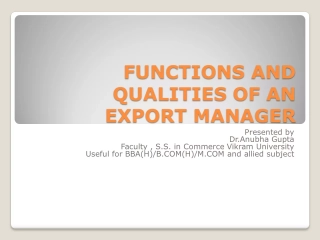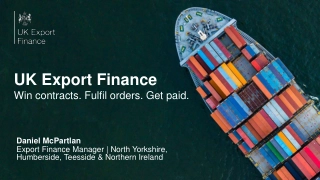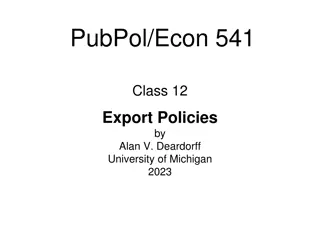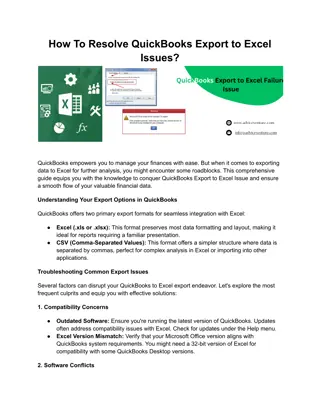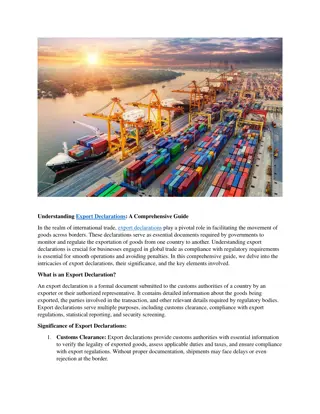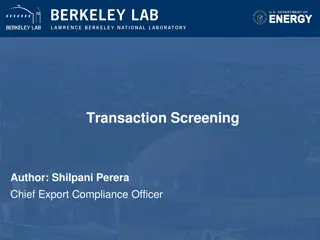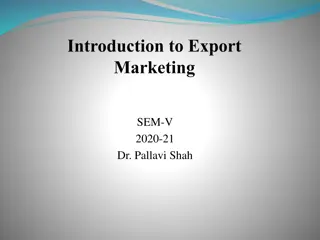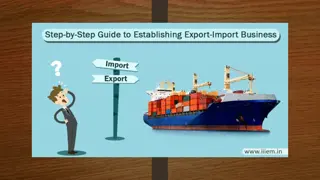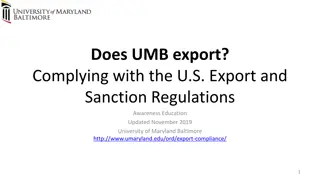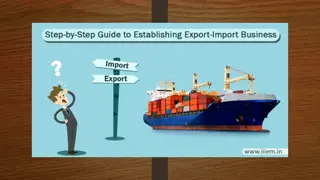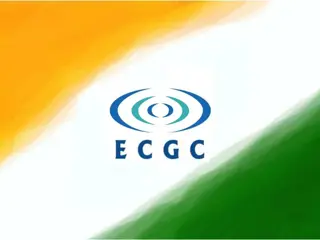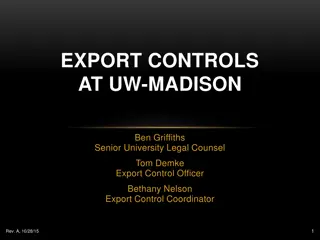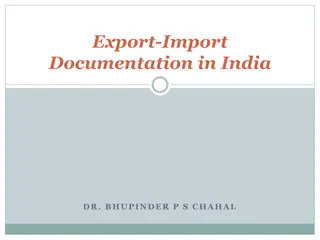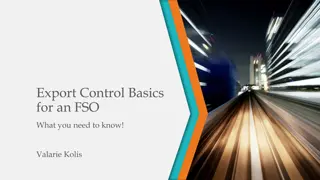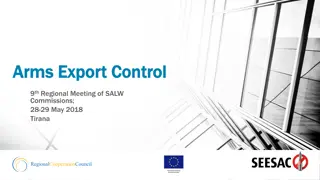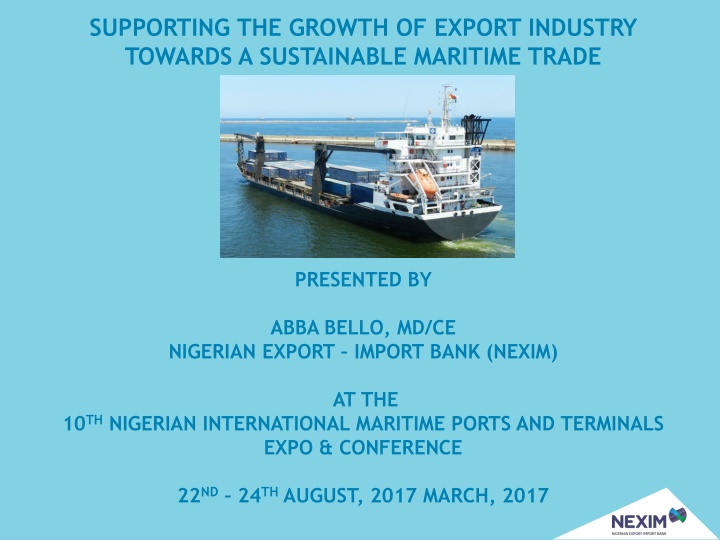
Supporting Export Industry Growth and Maritime Trade Development
"Learn about Nigeria's trade patterns, challenges in maritime trade and export growth, NEXIM's role in sustainable development, and the global impact of maritime trade. Discover the decline in imports and exports, the importance of maritime connectivity, and the need for infrastructure development. Explore statistical data and insights presented by Abba Bello at the Nigerian International Maritime Ports and Terminals Expo & Conference in August 2017."
Download Presentation

Please find below an Image/Link to download the presentation.
The content on the website is provided AS IS for your information and personal use only. It may not be sold, licensed, or shared on other websites without obtaining consent from the author. If you encounter any issues during the download, it is possible that the publisher has removed the file from their server.
You are allowed to download the files provided on this website for personal or commercial use, subject to the condition that they are used lawfully. All files are the property of their respective owners.
The content on the website is provided AS IS for your information and personal use only. It may not be sold, licensed, or shared on other websites without obtaining consent from the author.
E N D
Presentation Transcript
SUPPORTING THE GROWTH OF EXPORT INDUSTRY TOWARDS A SUSTAINABLE MARITIME TRADE PRESENTED BY ABBA BELLO, MD/CE NIGERIAN EXPORT IMPORT BANK (NEXIM) AT THE 10THNIGERIAN INTERNATIONAL MARITIME PORTS AND TERMINALS EXPO & CONFERENCE 22ND 24THAUGUST, 2017 MARCH, 2017
PRESENTATION OUTLINE INTRODUCTION NIGERIA S TRADE PATTERN CHALLENGES TO MARITIME TRADE AND EXPORT GROWTH AND DEVELOPMENT NEXIM S ROLE IN SUPPORTING EXPORT AND SUSTAINABLE MARITIME DEVELOPMENT CONCLUDING REMARKS Presentation title in footer 2
1.0 INTRODUCTION Import Trade Statistical data gleaned from the CBN Annual Reports between 2013 and 2015 showed general decline in Nigeria s importrecently; Decline in imports value / volume of both oil and non-oil with oil imports declining about 38% and non-oil declining by 10% in 2015 About 70% of non-oil imports are from countries with strong maritime industry and shipping lines as per summary of Top 8 non-oil imports to Nigeria Ranking Country % Share 1 China 32.9% 2 United States of America 11.4% 3 India 8.0% 4 United Kingdom 5.3% 5 Germany 4.2% 6 Netherlands 3.6% 7 Italy 2.1% 8 Japan 1.8% Source: CBN Annual Reports 2015 Presentation title in footer 3
1.0 INTRODUCTION Cont d Export Trade On export trade, statistical data (2014 and 2015) from the both CBN Annual Reports and the World Bank showed also a declining trend in percentage contribution of exports of goods and services to GDP; Year % of Aggregate Merchandise Exports to GDP 2013 15.8% 2014 14.6% 2015 9.6% Source: CBN Annual Accounts On comparative basis, Nigeria s exports of goods and services is far below the global annual average of about 30% as per summary below; Percentage Share of Exports of Goods and Services to GDP Year Nigeria World s Average 2013 18.05% 30.40% 2014 18.44% 30.28% 2015 10.63% 29.37% Source: World Bank Presentation title in footer 4
2.0 CHALLENGES TO MARITIME TRADE AND EXPORT GROWTH AND DEVELOPMENT Over 90% of the world's trade is carried by sea, which is by far the most cost-effective way of moving cargoes around the world. However, it is disconcerting to note that; African container traffic is less than 1% of total world container traffic of over 400 million containers Intra-ECOWAS trade had increased in the past decade from about 5 million tonnes to over 13 million tonnes without corresponding increase in transport infrastructure, especially maritime transport and connectivity. Nigeria sintra-regional trade has muted at about 15% and 12% for African and ECOWAS trade respectively over the past five years. Presentation title in footer 5
2.0 CHALLENGES TO MARITIME TRADE AND EXPORT GROWTH AND DEVELOPMENT Cont d The foregoing issues and opportunities to grow trade and increase maritime activities are being constraint by the following challenges; The lack of adequate transportation infrastructure and congestion on trade corridors ports and borders. Africa s annual transport Infrastructure gap is estimated at US$41 billion High transportation costs and excessive transit time that makes intra- regional trade non-competitive. These constraints therefore, make West Africa transport and logistics costs one of the highest in the World. Absence of a dedicated safe and modern fleet to encourage and facilitate Atlantic Short-Sea Trade along the West and African regions Non-Tariff Measures Barriers to trade growth and development, leading to high level of informal trade Presentation title in footer 6
2.0 CHALLENGES TO MARITIME TRADE AND EXPORT GROWTH AND DEVELOPMENT Cont d Due to the subsistence of some of the above challenges, Nigeria s and sub- Saharan African Performance Logistics Index (LPI) have the lowest international score on perception on logistics according to the World Bank, which are based on six key dimensions - efficiency of customs clearance process, quality of trade- and transport-related infrastructure, ease of arranging competitively priced shipments, quality of logistics services, ability to track and trace consignments, and frequency with which shipments reach the consignee within the scheduled time. 2016 Logistics Performance Index (LPI) Scores 3.23 3.14 2.89 2.66 2.62 2.47 SUB-SAHARAN AFRICA SOUTH ASIA LATIN AMERICA & CARRIBEAN MIDDLE EAST & NORTH AFRICA EAST ASIA & PACIFIC EUROPE & CENTRAL ASIA Presentation title in footer 7
3.0 NEXIMS ROLE IN SUPPORTING EXPORTS AND SUSTAINABLE MARITIME DEVELOPMENT The Nigerian Export Import Bank was established by Act 38 of 1991 as Nigeria s Export Development Bank. The Bank s broad mandate include the provision of the following to support and facilitate Nigeria s export trade; Credit Facilities in both local and foreign currencies, Risk-bearing facilities - Export Credit Guarantee & Export Credit Insurance Business Development and Financial Advisory Services Trade & Market Information On its developmental role to bridge infrastructure gap, especially toward ensuring intra-regional export growth and development of the maritime sector, the Bank is partnering with the Organized Private Sector (OPS) and key stakeholders like the Nigerian Shippers Council to promote the Regional Sealink Project. The Sealink is designed with a view to reduce high transportation / logistics costs that would enhance efficiency, competitiveness and trade connectivity within the West and Central African Regions. Presentation title in footer 8
3.0 NEXIMS ROLE IN SUPPORTING EXPORTS AND SUSTAINABLE MARITIME DEVELOPMENT Cont d The Sealink is designed principally with a view to reduce high transportation / logistics costs that would enhance efficiency, competitiveness and trade connectivity within the West and Central African Regions. While arrangements to commence pilot scheme of the Sealink before year end is at advanced stage in partnership with the Regional Sealink Consortium, it is pertinent to highlight other objectives of the project to the country and operational mandate of NEXIM; a) Provision of dedicated regional maritime services to promote connectivity, trade frequency and moderate transport cost, thereby facilitating formal / recorded trade within the Sub-Region; b) Broadening trade prospects and improving market access for regional goods and services; c) Deepening payment systems and enhancing the utilization of internationally recognized trade payment instruments Presentation title in footer 9
REGIONAL SEALINK PROJECT Presentation title in footer 10
Thank You www.regionalsealink.com Presentation title in footer 11

